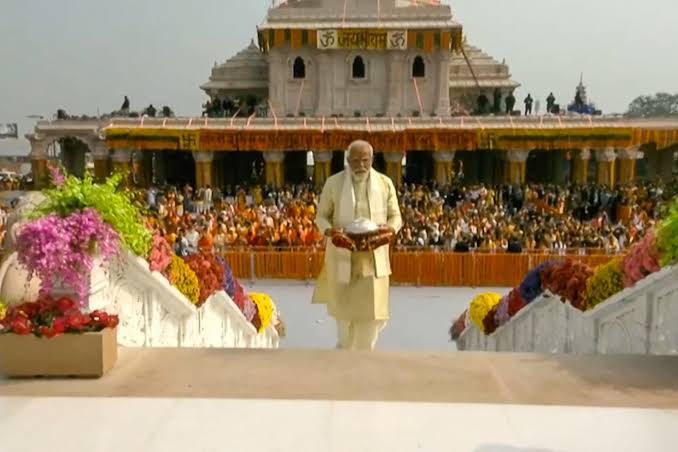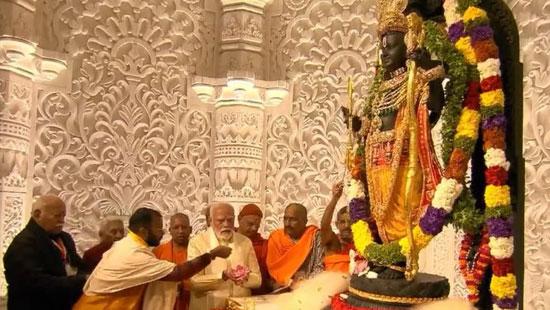Over thirty years after a group of militant Hindu radicals destroyed a mosque in the Indian town of Ayodhya, the Prime Minister of India, Narendra Modi, has officially inaugurated a new Hindu temple in its place.
The inauguration is considered a highly significant religious event by some, as many Hindus view Ayodhya as the birthplace of the revered deity Ram. The construction of the temple, following more than a century of disputes, is seen as the fulfilment of a long-held dream, symbolizing the return of Ram to his rightful place and India’s liberation from historical religious occupation. Modi himself described it as the realization of a dream cherished by many for years. During the Prana Pratishtha, the rituals held on Monday to consecrate the temple, offer blessings, and worship the idol of the young Ram placed in the inner sanctum, Modi played a prominent role.
 He had spent the previous 11 days observing a special purification ritual in preparation for the event. The consecration of the Ram temple became a nationwide spectacle, attended by 8,000 official guests, including politicians, diplomats, Bollywood stars, and religious leaders. Hundreds of thousands of pilgrims from across the country travelled to Ayodhya to express their devotion to the new temple and Ram. The town underwent a government-funded transformation costing $3 billion, adorned with flowers, saffron flags, images of Ram, and billboards featuring Modi. Arjun Kumar, a 22-year-old driver, undertook a significant journey, covering a distance of 466 miles (750km) from Delhi to Ayodhya over 20 days on a pilgrimage. Regarding this expedition, he expressed its utmost importance, considering it as the most pivotal journey of his life. Despite reservations from some friends, he emphasized their commitment as followers of Ram and Narendra Modi, asserting that nothing could hinder their path.
He had spent the previous 11 days observing a special purification ritual in preparation for the event. The consecration of the Ram temple became a nationwide spectacle, attended by 8,000 official guests, including politicians, diplomats, Bollywood stars, and religious leaders. Hundreds of thousands of pilgrims from across the country travelled to Ayodhya to express their devotion to the new temple and Ram. The town underwent a government-funded transformation costing $3 billion, adorned with flowers, saffron flags, images of Ram, and billboards featuring Modi. Arjun Kumar, a 22-year-old driver, undertook a significant journey, covering a distance of 466 miles (750km) from Delhi to Ayodhya over 20 days on a pilgrimage. Regarding this expedition, he expressed its utmost importance, considering it as the most pivotal journey of his life. Despite reservations from some friends, he emphasized their commitment as followers of Ram and Narendra Modi, asserting that nothing could hinder their path.
 Arjun believed it was essential for every Hindu to undertake this pilgrimage to convey a message about their rightful ownership of the country. After the ceremony, devotees gathered near Ram Mandir, including Bharat Patel, a 52-year-old herbal medicine seller from Gujarat. Patel shared his emotional experience, mentioning that upon reaching the temple and witnessing its magnificence, he was overwhelmed and shed tears, describing the moment as heavenly. He expressed immense pride, stating that it marked a significant achievement for Hindus worldwide. However, not all individuals participated in the ceremony, with some choosing to boycott it. They accused Modi of orchestrating the event for political motives ahead of the upcoming elections in spring, where he seeks a third term in office. The demolition of the mosque in 1992 paved the way for the rise of Hindu nationalism as a dominant political force.
Arjun believed it was essential for every Hindu to undertake this pilgrimage to convey a message about their rightful ownership of the country. After the ceremony, devotees gathered near Ram Mandir, including Bharat Patel, a 52-year-old herbal medicine seller from Gujarat. Patel shared his emotional experience, mentioning that upon reaching the temple and witnessing its magnificence, he was overwhelmed and shed tears, describing the moment as heavenly. He expressed immense pride, stating that it marked a significant achievement for Hindus worldwide. However, not all individuals participated in the ceremony, with some choosing to boycott it. They accused Modi of orchestrating the event for political motives ahead of the upcoming elections in spring, where he seeks a third term in office. The demolition of the mosque in 1992 paved the way for the rise of Hindu nationalism as a dominant political force.
 The commitment to constructing a Ram Temple in Ayodhya has remained a central element of Modi’s Bharatiya Janata Party’s (BJP) political agenda, aiming to establish Hindu supremacy in India. The temple is scheduled for completion next year, leading to objections from some Hindu religious leaders against its early inauguration. Alongside Prime Minister Modi, other participants in Monday’s temple consecration ceremony included Yogi Adityanath, the assertive Hindu monk and Chief Minister of Uttar Pradesh from the BJP, and Mohan Bhagwat, the leader of the Rashtriya Swayamsevak Sangh, a right-wing Hindu paramilitary organization that gave rise to the BJP. Kapil Komireddi, the author of “Malevolent Republic: A Short History of New India,” expressed concern about the close alignment between the prime minister and the Ram temple, seeing it as indicative of the BJP’s threat to India as a secular republic that constitutionally upholds equality among all religions. He described the event as a political spectacle, the culmination of a 40-year political project achieved through significant violence.
The commitment to constructing a Ram Temple in Ayodhya has remained a central element of Modi’s Bharatiya Janata Party’s (BJP) political agenda, aiming to establish Hindu supremacy in India. The temple is scheduled for completion next year, leading to objections from some Hindu religious leaders against its early inauguration. Alongside Prime Minister Modi, other participants in Monday’s temple consecration ceremony included Yogi Adityanath, the assertive Hindu monk and Chief Minister of Uttar Pradesh from the BJP, and Mohan Bhagwat, the leader of the Rashtriya Swayamsevak Sangh, a right-wing Hindu paramilitary organization that gave rise to the BJP. Kapil Komireddi, the author of “Malevolent Republic: A Short History of New India,” expressed concern about the close alignment between the prime minister and the Ram temple, seeing it as indicative of the BJP’s threat to India as a secular republic that constitutionally upholds equality among all religions. He described the event as a political spectacle, the culmination of a 40-year political project achieved through significant violence.

Komireddi sees it as the elevation of Hinduism to India’s state religion and a pivotal moment in building the cult of personality around Modi, viewing it as a regrettable development for India. Disputes over the Ayodhya holy site have roots dating back over a century, with the construction of the Babri Masjid mosque in 1528 by the Mughal emperor Babur. Hindus later asserted their right to worship at the site, believing it to be the birthplace of Ram. Muslims continued their worship at Babri Masjid until 1949, when a small extremist Hindu faction intervened, asserting that a temple had previously occupied the site and vowing to “liberate” the land for reconstruction.
Subsequently, an idol of Ram was placed in the mosque, purportedly by a Hindu priest, and the gates were sealed. The movement to reclaim Ayodhya and construct a temple gained traction among right-wing Hindu groups in the 1980s. By 1990, the BJP leaders, then an emerging political party, actively supported the cause, organizing marches to Ayodhya. In December 1992, a mob descended upon Ayodhya, employing sledgehammers, axes, and iron rods to demolish the mosque in a matter of hours, with several prominent BJP figures in attendance.


